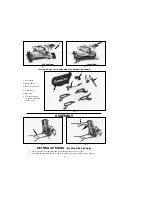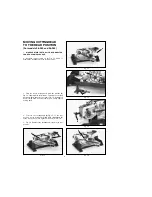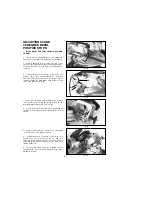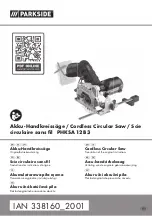
16
Fig. 44
Fig. 45
Fig. 46
Fig. 47
ADJUSTING 90 AND
45 DEGREE BEVEL
POSITIVE STOPS
1.
DISCONNECT THE TOOL FROM THE POWER
SOURCE.
2.
Loosen bevel lock handle and move the cuttinghead
all the way to the right. Then tighten bevel lock handle.
3.
Using a square (A) Fig. 44, place one end of the
square on the table and the other end against the blade,
as shown. Check to see if the blade is at 90 degrees to
the table.
4.
If an adjustment is necessary, loosen bevel lock
handle. Then loosen locknut (B) Fig. 45, and turn
adjusting screw (C) until head of screw (C) contacts
inside of casting (D) when blade is 90 degrees to the
table. Then tighten locknut (B).
5.
When you are certain blade is 90 degrees to table,
loosen screw (J) Fig. 46, and adjust pointer (H) to line up
with the 0 degree mark on bevel scale (K).
6.
Loosen bevel lock handle and move cuttinghead all
the way to the left bevel position and tighten bevel lock
handle.
7.
Using a square (A) Fig. 47, check to see if the blade
is at 45 degrees to the table, as shown.
8.
If an adjustment is necessary, loosen bevel lock
handle. Then loosen locknut (E) Fig. 45, and turn
adjusting screw (F) until head of screw (F) contacts
surface (G) when blade is 45 degrees to the table. Then
tighten locknut (E).
9.
These positive stops enable you to rapidly position
the blade at the most common bevel angles to the table,
90 and 45 degrees.
A
C
B
D
G
E
F
J
K
H
A
Summary of Contents for 36-240
Page 32: ...32 NOTES...
















































